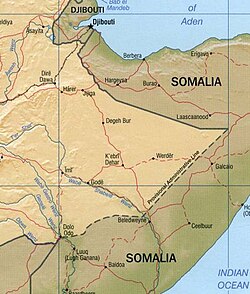Ogaden region
|
Ogaden Ogaadeen أوغادين |
||
|---|---|---|
|
||
 Shaded relief map of Ethiopia, cropped and centered on the Ogaden area |
||
| Region (non-administrative) | Ogaden | |
| Area | ||
| • Total | 327,068 km2 (126,282 sq mi) | |
| Population (July 2012) | ||
| • Total | 5,148,989 | |
| • Density | 16/km2 (41/sq mi) | |
| ISO 3166 code | ET-SO | |
Ogaden (pronounced and often spelled Ogadēn; Somali: Ogaadeen) is the unofficial name of the Somali Region, the territory comprising the eastern portion of Ethiopia. The inhabitants are predominantly ethnic Somali and Muslim. The title "Ogaden" is often preferred by the international communities.
The region, which is around 200,000 square kilometres, borders Djibouti, Somalia and Kenya. Important towns include Jijiga, Degahbur, Gode, Kebri Dahar, Fiq, Shilabo, Kelafo, Werder and Danan.
The Ogaden is a plateau, with an elevation above sea level that ranges from 1,500 metres in the northwest, falling to about 300 metres along the southern limits and the Wabi Shebelle valley. The areas with altitudes between 1,400 and 1,600 metres are characterised as semi-arid; receiving as much as 500–600 mm of rainfall annually. More typical of the Ogaden is an average annual rainfall of 350 mm and less. The landscape consists of dense shrubland, bush grassland and bare hills. In more recent years, the Ogaden has suffered from increasingly erratic rainfall patterns, which has led to an increasing frequency of major droughts: in 1984–85; 1994; and most recently in 1999–2000, during which pastoralists claim to have lost 70–90 percent of their cattle.
There are few historical texts written about the people who lived in what is known today as the Ogaden region of Ethiopia. Ogaden was part of the Somali Ifat Sultanate in the 13th and beginning of the 14th centuries AD. The borders of the sultanate extended to the Shewa - Addis Ababa area of Ethiopia. The Ifat Sultanate was succeeded by the Adal Sultanate. There was an ongoing conflict between the Adal Sultanate and the Christian Kingdom of Abyssinia throughout this time. During the first half of the 16th century, most of Abyssinian territory was conquered and came under the rule of Adal, when Ahmad ibn Ibrahim al-Ghazi, the leader of the Somali-dominated Adal's Army, took control.
...
Wikipedia

